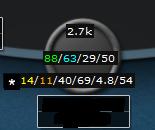Member Comments
No comments so far
 WSD (sometimes labeled as W$SD) indicates how often a player wins when they go to showdown. If they are able to fold a hand that is beaten before they get to showdown, then they will typically win showdowns more than weaker players who have trouble folding. In many games, this stat should be between 52% and 57%, but don’t even consider using those numbers as a reference until you have read the rest of this article.
WSD (sometimes labeled as W$SD) indicates how often a player wins when they go to showdown. If they are able to fold a hand that is beaten before they get to showdown, then they will typically win showdowns more than weaker players who have trouble folding. In many games, this stat should be between 52% and 57%, but don’t even consider using those numbers as a reference until you have read the rest of this article.
WSD can be important in giving you a good feel for how an opponent plays, but it is also highly dependent on the other information you have about them. With pre-flop stats, you just get clear information. The knowledge that a player raises before the flop 13% of the time is information that is highly useful even in a vacuum, but a player’s WSD requires knowledge of the other stats or it can be very misleading.
The reason WSD is different than the simpler stats is that in many games, there are multiple styles that can achieve similar win rates. A good example of this occurs in six-max No Limit cash games. The way many players beat these games is with lots of aggression and large bets. These players win because they buy a lot of pots and tend to be paid off heavily when they make a big hand, but when an opponent calls them down, they often lose the showdown. They are putting on so much pressure that their opponents won’t go to showdown with them unless they have a big hand.
These very aggressive players, especially if their bets tend to be large, will often have a WSD that is near 50%, and some very aggressive winning players will even be below that. If you saw an HUD on these players, you might believe they were maniacs because they are very loose and aggressive and aren’t winning showdowns, when in fact some of them are making a nice income playing this style.
The other way to beat six-max No Limit cash games is to pick off the overly aggressive players and win big pots while being willing to surrender the smaller pots. These players are usually going to be a little tighter pre-flop and win more pots at the showdown. Their stats will reflect a much higher WSD because they lay more traps and are usually going to have a strong hand when they go to showdown.
These players will often have WSD numbers as high as 55% and may have a similar win rate to players who had a WSD around 50%. In typical players, that 5% would be the difference between a winner and a loser, but with a big difference in aggression, the two players may have the same win rate. Because of this, I would be remiss in giving out exact numbers for WSD and telling you where you should fit if you want to win. Higher is generally better than lower and a goal of 55% is reasonable in many games, but when you are reading opponents, their WSD is simply a piece of the puzzle and relies heavily on the other stats.
It is also important to have a large sample size when relying on WSD to tell you about whether an opponent is a calling station (below 50% and low aggression numbers) or easily bluffed (WSD over 55%). WSD is not tested nearly as often as pre-flop stats are; we can see how we need more hands to trust this stat in the example below.
If we have 1,000 hands on an opponent, then we have seen them decide whether to put in money voluntarily 1,000 times. A few of those times, someone with a larger stack will be all-in and the only options will be to call or fold, so the PFR stat may have only been tested 950 times. If the player has a VPIP of 15%, then they may have seen the flop 16% of the time (sometimes they see a free flop from the big blind).
Of those 160 times they were able to see a flop, they may have only gone to showdown 35% of the time for a total of 56 showdowns. Winning showdowns has a much larger luck factor than VPIP or PFR because those stats don’t require a player to win anything; they just decide based on the strength of their hand. In 56 hands, VPIP may start to give you some idea of how loose or tight an opponent is, while WSD may not be accurate at all. A few unlucky hands will drive that number down quickly as well.
Let’s assume our player with 1,000 hands and 56 showdowns would usually win 30 of them because he wins 53.5% of his showdowns. If he has just three hands go badly that he should have won, he only wins 27 of the 56 hands and your HUD will indicate that he only wins 48% of his showdowns. You could assume that this solid player was actually a calling station because 1,000 hands weren’t nearly enough to get a feel for how often he won when he went to showdown.
WSD can be a very useful stat, and for cash game players who have very large samples on some of their opponents it can really increase win rate, but be careful with it, as it can easily mislead.
Check out our articles on interpreting VPIP, PFR, AF, and 3bet stats.
No comments so far